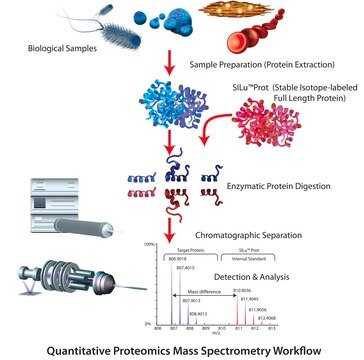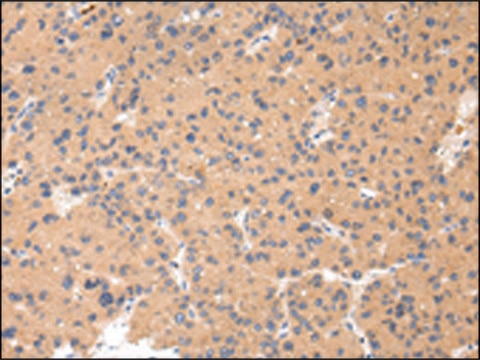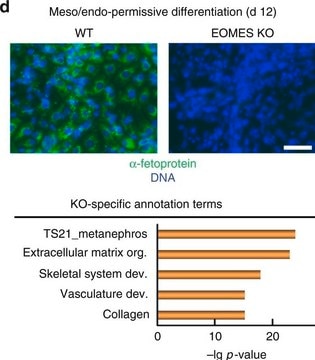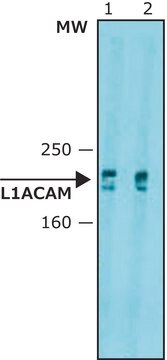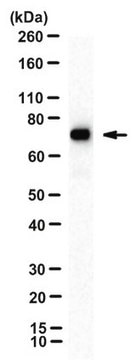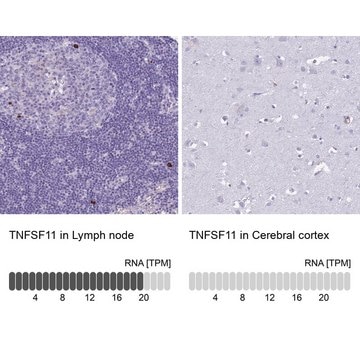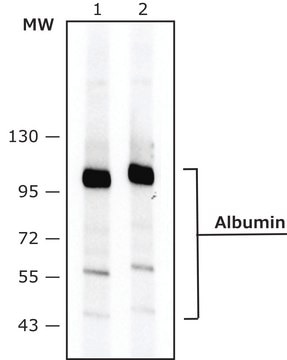MABS445
Anti-Sclerostin Antibody, clone 7B6.1 | MABS445
culture supernatant, clone 7B6.1, from mouse
Synonym(s):
Sclerostin
Sign Into View Organizational & Contract Pricing
All Photos(1)
About This Item
UNSPSC Code:
12352203
eCl@ss:
32160702
NACRES:
NA.41
Recommended Products
biological source
mouse
Quality Level
antibody form
culture supernatant
antibody product type
primary antibodies
clone
7B6.1, monoclonal
species reactivity
rat, human
technique(s)
immunohistochemistry: suitable
western blot: suitable
isotype
IgG2bκ
NCBI accession no.
UniProt accession no.
shipped in
dry ice
target post-translational modification
unmodified
Gene Information
human ... SOST(50964)
General description
Sclerostin (UniProt Q9BQB4) is encoded by the SOST (also known as CDD, SOST1, VBCH) gene (ORP UNQ2976/PRO7455/PRO7476; Gene ID 50964) in human. Sclerostin is a glycoprotein expressed in osteocytes and functions as a negatively regulator against bone mass by antagonizing low density lipoprotein receptor-related proteins- (LRP5-/LRP6-) mediated WNT/beta-catenin pathway signaling. Sclerostin levels are increased in the post-menopausal women and elderly and in long term immobilized patients. Sclerostin neutralizing antibody is reported to enhance bone formation, mass, and strength in aged male rats. Sclerostin and its inhibitors have potential in prosthetic, regenerative and preventive therapy in dentistry.
Specificity
Detects Sclerostin isoform 1 (UniProt Q9BQB4-1). Reactivity toward the spliced isoform 2 (UniProt Q9BQB4-2) is likely, but has not been determined.
Immunogen
Epitope: Internal
GST-tagged recombinant protein corresponding to the internal fragment of human Sclerostin.
Application
Anti-Sclerostin Antibody, clone 7B6.1 | MABS445 is an antibody against Sclerostin Antibody for use in Western Blotting and Immunohistochemistry.
Immunohistochemistry Analysis: A 1:250 dilution from a representative lot detected Sclerostin in human kidney, rat liver and human liver tissue.
Research Category
Signaling
Signaling
Research Sub Category
Developmental Signaling
Developmental Signaling
Quality
Evaluated by Western Blotting in GST-tagged Sclerostin recombinant protein.
Western Blotting Analysis: A 1:500 dilution of this antibody detected 0.5 µg of GST-tagged Sclerostin recombinant protein.
Western Blotting Analysis: A 1:500 dilution of this antibody detected 0.5 µg of GST-tagged Sclerostin recombinant protein.
Target description
24 kDa calculated
Physical form
Mouse monoclonal IgG2bκ antibody tissue culture supernatant without preservatives.
Unpurified
Storage and Stability
Stable for 1 year at -20°C from date of receipt.
Handling Recommendations: Upon receipt and prior to removing the cap, centrifuge the vial and gently mix the solution. Aliquot into microcentrifuge tubes and store at -20°C. Avoid repeated freeze/thaw cycles, which may damage IgG and affect product performance.
Handling Recommendations: Upon receipt and prior to removing the cap, centrifuge the vial and gently mix the solution. Aliquot into microcentrifuge tubes and store at -20°C. Avoid repeated freeze/thaw cycles, which may damage IgG and affect product performance.
Other Notes
Concentration: Please refer to lot specific datasheet.
Disclaimer
Unless otherwise stated in our catalog or other company documentation accompanying the product(s), our products are intended for research use only and are not to be used for any other purpose, which includes but is not limited to, unauthorized commercial uses, in vitro diagnostic uses, ex vivo or in vivo therapeutic uses or any type of consumption or application to humans or animals.
Not finding the right product?
Try our Product Selector Tool.
wgk_germany
WGK 2
flash_point_f
Not applicable
flash_point_c
Not applicable
Certificates of Analysis (COA)
Search for Certificates of Analysis (COA) by entering the products Lot/Batch Number. Lot and Batch Numbers can be found on a product’s label following the words ‘Lot’ or ‘Batch’.
Already Own This Product?
Find documentation for the products that you have recently purchased in the Document Library.
Richard J Visconti et al.
Journal of bone and mineral research : the official journal of the American Society for Bone and Mineral Research, 36(10), 1914-1930 (2021-06-27)
Human myeloma bone disease (MBD) occurs when malignant plasma cells migrate to the bone marrow and commence inimical interactions with stromal cells, disrupting the skeletal remodeling process. The myeloma cells simultaneously suppress osteoblastic bone formation while promoting excessive osteoclastic resorption.
Our team of scientists has experience in all areas of research including Life Science, Material Science, Chemical Synthesis, Chromatography, Analytical and many others.
Contact Technical Service
